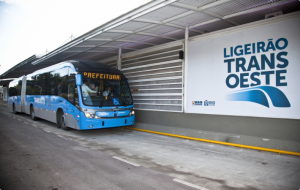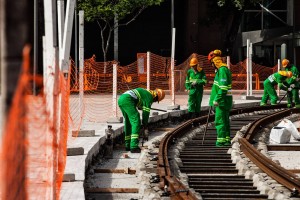RIO DE JANEIRO, BRAZIL – One year ahead of the 2016 Olympic Games construction sites are a common sight in Rio de Janeiro as the city not only builds sporting facilities for the event, but transforms public transport. The impact on roadway traffic and transportation infrastructure, in the notoriously congested city, might well be one of the biggest legacies of the sports mega-event.

The biggest public transportation impact on the Zona Oeste (West Zone) of the city will be caused by the three BRT (Bus Rapid Transit) lines that connect Recreio and Barra with Galeão Airport and Deodoro. While the Transoeste BRT line connecting the Alvorada terminal in Barra da Tijuca with Recreio has been already successfully running since June 2012, the Transcarioca opened in 2014 creating a link between Rio’s international airport and Barra da Tijuca.
The Transolimpica between Recreio and Deodoro is currently under construction and to 65 percent complete according to Cidade Olímpica. It will reduce traveling time from two hours between the two locales to just thirty minutes.
A fourth line, the Transbrasil, connecting Deodoro with Caju in the city’s Port Zone was called into action after the success of the other lines. Construction has started in November 2014 and will link to other transportation means like the metro and SuperVia. The Transbrasil will also goes along the heavily traveled Avenida Brasil and is estimated to transport 700,000 people per day.
Within Centro, the two biggest changes in transportation are the destruction of the Perimetral highway and the introduction of the VLT (vehicle on light tracks) tram. Rio Mayor Eduard Paes even called the demolition of the Perimetral the main legacy for the city in an interview with G1.

“It was a wall dividing the city in between its reason for being [Guanabara Bay],” Paes explained. With the demolition of the highway came several traffic changes in Centro, including the new Rio 450 tunnel and better integration of the modernized Port Zone.
“A lot of what is for the Olympics: the BRT, the metro expansion, the demolition of the Perimetral, are things the city asked for for a long time and the Olympics helped a lot in this process. I look at the city as if it was an athlete with a goal to reach and obstacles to overcome. The city is behaving in that sense,” Paes continued.
Several transportation projects are also underway improving the connection between the city’s Zona Sul (South Zone) and Barra da Tijuca. The most important project for public transport is the extension of the metro service with the new Line 4, which will open in June 2016.
The new Metro Line 4 will connect Ipanema with Jardim Oceanico in Barra da Tijuca, which will also receive an extended Transoeste BRT station. Traveling time from Ipanema to Barra will be around fifteen minutes and a journey from Centro to Barra will take 34 minutes.
On the street, the Joá highway, a bottleneck in between São Conrado and Barra, is currently being enlarged to allow for smoother traffic and more cars to take the road. The new Joá will also feature a bike path along its way connecting the bike paths from Zona Sul to Barra as well.
Nevertheless, some complain that Rio has not done everything to promote biking in the city. Unlike promised, there will be no bike paths connecting the Maracanã continuously to Barra da Tijuca and Deodoro will also remain isolated. There will also be no cycling connection between the Engenhão and the Maracanã, even though the two are only 8km apart.